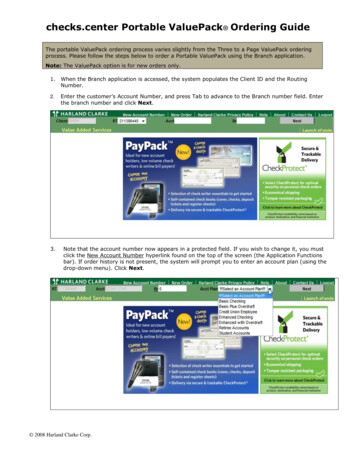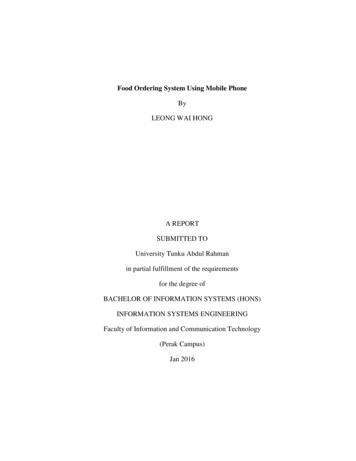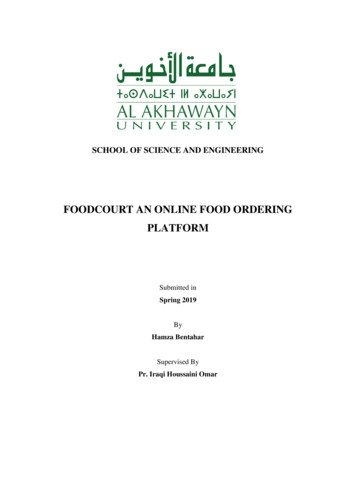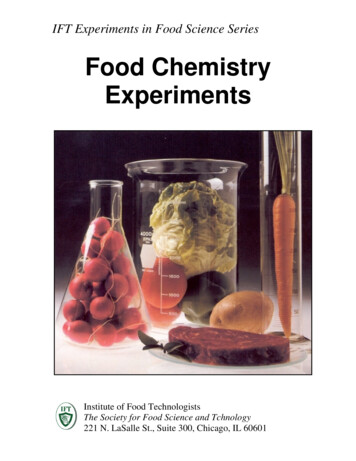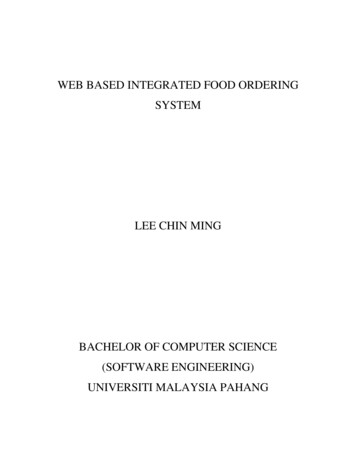
Transcription
WEB BASED INTEGRATED FOOD ORDERINGSYSTEMLEE CHIN MINGBACHELOR OF COMPUTER SCIENCE(SOFTWARE ENGINEERING)UNIVERSITI MALAYSIA PAHANG
ivExecutive summaryAs the internet technology has become essential for human life, diversity of webbased system or online system has been created to fulfill increasing customer demand.Nowadays, variety of existing manual system was replaced by a web-based system due tothe time-consuming manual systems and unsolvable limitations appeared. In this paper, aweb based ordering system is proposed for replacing existing manual system. Thissystem will allowed user to make order, updating menu, uploading file, submittingdocument and so on. The main user requirement collection method is by interviewingusers and stakeholders. Based on the research, mostly web based system has been usedfor business and education that beneficial to business people, students and lecturers.Therefore, lecturers and students can easily access the web based system through internetby using computer or mobile device to get the latest information or announcement. Onthese few years, the development of system has been dramatically influenced by webtechnology as a platform for different types of system. The web based systemdevelopment has been growing due to the highly recommended from user in order toreplace the non-web based system or manually system.
vRingkasan EksekutifSeperti teknologi internet telah menjadi penting untuk kehidupan manusia,kepelbagaian sistem berasaskan web atau sistem dalam talian telah diwujudkan untukmemenuhi permintaan yang semakin meningkat pelanggan. Kini, pelbagai sistem manualyang sedia ada digantikan dengan sistem berasaskan web disebabkan oleh sistem manualyang memakan masa dan batasan unsolvable muncul. Dalam kertas kerja ini, satu sistemberasaskan web pesanan adalah dicadangkan untuk menggantikan sistem manual yangsedia ada. Sistem ini akan membolehkan pengguna untuk membuat pesanan, mengemaskini menu, fail muat naik, mengemukakan dokumen dan sebagainya. Pengguna kaedahpengumpulan keperluan utama adalah dengan menemuramah pengguna dan pihak yangberkepentingan. Berdasarkan kajian, kebanyakannya sistem berasaskan web telahdigunakan untuk perniagaan dan pendidikan yang memberi manfaat kepada orang-orangperniagaan, pelajar dan pensyarah. Oleh itu, pensyarah dan pelajar boleh mengaksessistem berasaskan web melalui internet dengan menggunakan komputer atau perantimudah alih untuk mendapatkan maklumat terkini atau pengumuman. Pada beberapatahun, pembangunan sistem telah secara mendadak dipengaruhi oleh teknologi websebagai platform untuk pelbagai jenis sistem. Pembangunan sistem berasaskan web telahberkembang akibat yang sangat disyorkan dari pengguna dalam usaha untukmenggantikan sistem yang bukan berasaskan web atau manual sistem.
viTABLE OF E SUMMARYivRINGKASAN EKSEKUTIFvCONTENTSviLIST OF TABLESviiiLIST OF FIGURESxiSectionContentPageCHAPTER 1INTRODUCTION11.1Problem Formulation21.21.1.1 Objective1.1.2 Problem StatementPrevious work and relationship to current project2231.2.11.2.21.2.31.2.434561.3Manual Food Ordering SystemWaiter Paging SystemTouch Screen Ordering SystemWireless Food Ordering System Based on WebService1.2.5 Mobile Food Ordering System (MFOS)1.2.6 The Development of Self-service RestaurantOrdering System (SROS)Limitation of current system1.4Terminology91.5Method approach101.6Scope or limitation of study101.7Outline of material presented in rest of report10789
viiCHAPTER 2REPORT BODY112.1User Requirement112.22.1.1 Types of user2.1.2 Software2.1.3 HardwareDesign Description111213132.32.2.1 Context Diagram2.2.2 Use Case Diagram2.2.3 Flow ChartMethod and materials used131414192.42.3.1 Planning Phase2.3.2 Requirement Phase2.3.3 Analysis and Design Phase2.3.4 Development and Implementation Phase2.3.5 Testing Phase2.3.6 Maintenance PhaseDiscussion and Result192020212121222.4.12.4.222232.5CHAPTER 3Result AnalysisSoftware Engineering NDIX A - Gantt chart of PSM 1 and PSM 229APPENDIX B - Software Requirement Specification (SRS)31APPENDIX C - Software Design Description (SDD)70APPENDIX D - Software Test Report (STR)112APPENDIX E – User Manual136APPENDIX F - User Requirement (including official sign)157APPENDIX G - Acceptance Sign Off Form165
viiiLIST OF TABLESTable NumberTitlePage2.4Software Documentation names and description243.1Use Case of login function513.2Use Case of logout function523.3Use Case of register function533.4Use Case of view system function543.5Use Case of forget or change password function553.6Use Case of add function563.7Use Case of delete function573.8Use Case of update function583.9Use Case of verify function593.10Use Case of send document function603.11Use Case of order food / reserve banquet function613.12Use Case of send SMS624.1Data dictionary of budget984.2Data dictionary of cafe ex994.3Data dictionary of cafe ex info994.4Data dictionary of category1004.5Data dictionary of contact1004.6Data dictionary of enquiry1014.7Data dictionary of image1014.8Data dictionary of kk11024.9Data dictionary of kk1 info1024.10Data dictionary of kk21034.11Data dictionary of kk2 info1034.12Data dictionary of menu added1044.13Data dictionary of menu ordered1044.14Data dictionary of invoice105
ix4.15Data dictionary of post1064.16Data dictionary of topic1064.17Data dictionary of user1071.1Project Reference1161.2Document Reference1163.1Test cases for login function1213.2Test cases for registration function1223.2.1Test cases for registration function in scenario 11233.2.2Test cases for registration function in scenario 21233.3Test cases for food ordering/banquet reservation126function3.3.1Test cases for food ordering function in scenario 11273.3.2Test cases for food ordering function in scenario 21273.3.3Test cases for food ordering function in scenario 3128Test cases for Update Data / Info function130Test cases for Update Data / Info function in scenario 1131Test cases for View and Send Invoice function132Test cases for View and Send Invoice function in1333.43.4.13.53.5.1scenario 13.6Test cases for forum function134Test cases for forum function in scenario 11351.1Default username and password1392.1Home Page controls1402.2Photo Gallery Page controls1422.3Login Page Controls1442.4Contact Us Page controls1453.1Home Page (After Login) controls1463.2Ordering Page controls1483.3Previous Ordering Page controls1493.4Forum Page controls1513.6.1
x4.1View and Manage Database Page1524.2Send SMS Page controls1534.3Contact Information Page control1535.1Admin User View and Manage Database Page controls1545.2Create Invoice Page controls155
xiLIST OF FIGURESFigure NumberTitlePage1.1Waiter Paging system41.2Waiter Paging system 241.3Sakae Sushi’s Touch Screen System51.4MFOS71.5MFOS using I-Phone71.6SROS functional correlation82.1Context diagram of WBIFOS142.2Flow chart of login152.3Flow chart of registration152.4Flow chart of ordering152.5Flow chart of Update data / info162.6Flow chart of Verify budget and ordering172.7Flow chart of Send and View Invoice182.8Software Development Life Cycle of WBIFOS192.1Home page of WBIFOS402.2Login page of WBIFOS412.3Admin Home page of WBIFOS422.4Admin View and Manage Database page of WBIFOS422.5Admin User Database Management page432.6Change password page in WBIFOS474.1Use case of admin664.2Use case of admin user674.3Use case of general user684.4Sequence diagram of ordering693.1System Design Overview (Context Diagram)793.2Three-tier architecture803.3Component Diagram of WBIFOS83
xii3.4Functional Decomposition diagram of WBIFOS843.5Data Flow Diagram (DFD) level 0853.6Data Flow Diagram (DFD) level 1 Process 1.0863.7Data Flow Diagram (DFD) level 2 Process 1.2873.8Data Flow Diagram (DFD) level 1 Process 2.0883.9Data Flow Diagram (DFD) level 1 Process 3.0893.10Data Flow Diagram (DFD) level 1 Process 4.0903.11Data Flow Diagram (DFD) level 1 Process 5.0913.12State diagram of Web Based Integrated Food92Ordering System3.13State diagram of registration module933.14State diagram of food ordering or banquet reservation94module3.15State diagram for updating menu list and promotion95by admin user module3.16State diagram of verify budget / ordering module963.17State diagram of send and view invoice module974.1ER diagram for forum1084.2ER diagram for ordering1094.3ER diagram for database management1102.1Home page1402.2Photo Gallery Page1412.3After click the selected photo1422.4Login Page1432.5Contact Us Page1442.6After click the Email Icon1443.1Home Page (After login )1453.2Ordering Page1463.3Ordering Page (User Information)1473.4Previous Ordering Page148
xiii3.5Forum Category Page1493.6Forum Topic Page1493.7Topic Content Page1503.8Add Reply Page1514.1View and Manage Database Page1514.2Send SMS Page1524.3Contact Information Page1535.1Admin User View and Manage Database Page1545.2Create Invoice Page155
1IntroductionWith rise of internet has brought a different vision to the world since there aremany websites has been created that providing variety of useful information for us.Thus, the websites are become increasingly interest among the youngsters. Through thewebsites, it allowed us to access social network, information sources, web basedsystem, blogging, business, online shopping and so on. Nowadays, most of thecompanies are using websites or providing a web-based system and messagingtechnology to access and manage their data effectively and efficiency. Websites or webbased system was owned by millions of businesses as an effective channel forcommunication and information exchange or transactions with customers.In the business world, time is money. The creation of websites or web basedsystem will greatly beneficial to both companies and customers which allowed them toskip the queue and save their precious time without going to the store, some more thosecompanies can expand their business widely. Through the web based system, companyhaving capability to keep updating and maintain the customer’s custom, habit andinterest. Furthermore, food orders can be easily made by customer with their ownmobile device or computer from everywhere that having internet even when they aretraveling. They will receive different choices to compare menu and prices from varietyof food stores and their monthly specials or offers.Therefore, the web based integrated ordering system is created for FSKKP(Fakulti Sistem Komputer & Kejuruteraan Perisian) and cafeterias in order to replacethe existing manual ordering system. Being web based makes this system availableeverywhere through internet. This web based system will be fully integrates all theordering in three cafeterias (kk1, kk2 and café executive) for banquet reservation orfood ordering in Universiti Malaysia Pahang (UMP) Gambang only.
21.1Problem Formulation1.1.1 Objectivei.To develop integrated ordering system for banquet reservations or foodordering in UMP Gambang.ii.To develop system that replaces the manual procedure of faxing invoicefor cafeterias and FSKKP UMP.iii.To test the system function with user.1.1.2 Problem StatementThe existing manual system for banquet reservations or food ordering forFSKKP has high limitation and inconvenience to the staff or lecturer and cafeteriasowner. The manually ordering procedures are very time consuming task with the risk ofhuman error. Those staff FSKKP and cafeterias have to fax or sending those receipt,invoice and ordering information to each other and confirmed by assistant registrar. Themanual procedure on budget of banquet reservations or food ordering is time consumingand complicated due to the budget is required confirmation by treasurer after thevalidation of assistant registrar. Furthermore, lecturers or staff faculty are wasting timein directly facing cafeteria owner for banquet reservation or ordering. The risk of humanerror or mistake is getting serious due to the mobile phone has become an inconsistentway for them to communicate in ordering and information update.
31.2Previous work and relationship to current projectUnconsciously, the web based technology is becoming famous and making alarge impact on our lives. At present, few web based ordering system are available inthe market such as manual food ordering system, waiter paging system, touch screenordering system and wireless food ordering system based on web services. In thissection, those available web based ordering system will be briefly explained.1.2.1 Manual Food Ordering SystemThe traditional method for food ordering that customer orders are taken bywaiter or waitress is known as manual food ordering system. They found, “most of therestaurant around the world using the manual ordering system. This system is using awaiters and waitress to take an order from the customers. This system relies on largenumbers of manpower to handle customer reservation, inquiry, ordering food, placingorder, reminding dishes” (Noor et al., 2012). This kind of ordering system is consumingand wasting time or resources when having a lot of customers at that time. Other thanthat, waiting for a long queue is one of the inevitable processes in manual orderingsystem that face by customer during peak hour. It will increase the human risk andmisunderstanding between customer and waiter. Thus, the existing manual system thatapplies by FSKKP for banquet reservation or food ordering should be replaced by webbased system. If having any banquet in UMP, cafeteria and staff has to spend a lot oftime on manually procedures for banquet reservation or food ordering.
41.2.2 Waiter Paging SystemWaiter paging system shown in figure 1 and figure 2 is one of the food orderingsystems available in the market that allows customers to notify or call for a waiter. Theystated, “The pager unit notifies the waiter via a vibrator or buzzer that a request hasbeen received and displays the request” (Yong Chai et al., 2010). This system helpsrestaurant to improve the customer service and manage restaurant staffs more efficiencyand effectively. With this system, restaurant staffs and managers can manage and spendmore quality time with customers for keeping customer satisfied. Whether large orsmall restaurant, it can be handled ordering more productively and effectively. Throughthis system, waiter can instantly page when food is ready for pick up while it’s still hotand fresh. Furthermore, good quality of foods and services can be maintained andimproved by restaurant. The notification function on the waiter paging system is relatedand similar on sending message to user or client in the web based ordering system forany ordering information updated.Figure 1.1: Waiter Paging SystemFigure 1.2: Waiter Paging System
51.2.3 Touch Screen Ordering SystemNowadays, the touch screen technology has become widespread among theyoungster. This technology has been widely applied in mobile phone or smart phone,tablet, laptop and computer. The restaurant is trying to capture the demands ofcustomers with innovation in computing and technology. Thus, the touch screenordering system has been available in the market that allow customer make order byown self using touch pad that provided in every table dining. With this system, theprocess of food delivery and food ordering became much simpler. Incorporating theadvances in technology and computerization, better customer service is now much moreachievable with the touch screen system. Therefore, restaurant may not hire too muchwaiters to reduce the waste of resources and customers' dissatisfaction during peak hour(Yong Chai et al., 2010). For example, company Sakae Sushi is using touch screenordering system that provides for every customers to make their own order as shown infigure 3.Figure 1.3: Sakae Sushi’s Touch Screen System
61.2.4 Wireless Food Ordering System Based on Web ServiceWireless communication or WIFI technology has become an essential servicefor customer that supplied by most of the food and beverage company. They found,“current wireless communications technology enable people easily to exchangeinformation, while web services provide a low coupling coefficient or called looselycoupled and platform-independent ways of linking applications or system across theInternet or Intranet.” (Hong Zhen et al, 2009). Wireless technology allows customereasily accesses the website and web based system through internet rather thandepending on wired data access or mobile data access. Combining advance mobiledevice and wireless technology, extra features that allow the customers themselves toplace an order, review the menu and food ordering updated by using smart phone orcomputer. By integrating the wireless and web service technology, real world businesscan be carry out or fulfill on a wide various of devices, not only implement on mobilesdevices operating system, but also implement on computer, laptop and tablet (HongZhen et al, 2009). Therefore, the web based integrated ordering system should beapplied that allowing staff or lecturer FSKKP and cafeteria owner using WIFI foraccessing internet to make any banquet reservation or food ordering in UMP Gambang.
71.2.5 Mobile Food Ordering System (MFOS)The modern mobile devices offer different types of mobile phone for a widevariety of customer lifestyles and tastes. It has become a necessity and plays animportant role in our life. They found that “it feels so strange when we hear that it isonly 25 years since the first commercial cellular call was made in the United States, andtoday there are more than 262 million wireless subscribers in this country, 83% of thetotal Unites States population.” (HRISHIKESH, K et al., 2009). Therefore, mobile foodordering system has been developed for food ordering due to the growing popularityand ability of mobile devices and various of new system or technology are beinglaunched every day as shown in figure 4 and 5 (HRISHIKESH, K et al., 2009). Atpresent, all the web based systems are trying to compatible their system on mobiledevice platform for customers’ convenience. The capability of PDA (Personal DigitalAssistant) and current smart phone are benefit the end user on mobile shopping andordering. This system is using PDA or smart phone for user to place an order. It canprovides variety of food stores for a user’s selection, option of delivery for a user’sorder, list of cities, display the prices of different food items and so on. Currently,various types of applications are compatible and supporting the Android operatingsystem mobile phone, Windows phone and I-phone.Figure 1.4: MFOSFigure 1.5: MFOS using I-Phone
81.2.6 The Development of Self-service Restaurant Ordering System (SROS)SROS is one of the ordering systems that reducing the dependence of resourceand manpower for customer's order. Meanwhile, restaurant can minimize the monthlycost expenses and the waste of resources. SROS is designed using Microsoft VisualStudio 2008 and Microsoft Office Access 2007 to replace the manual restaurantordering system. This system using Microsoft Visual Studio 2008 to develop a graphicaluser interface (GUI) and Microsoft Office Access 2007 used for the system database(Noor et al., 2012). With the system, customers are allow placing an order, viewing themenu, and observe the food preparation at kitchen. The work flow of the SROS is thesystem home page will appeared when customers start using the system. This homepage contains the navigation, special offer prices or promotion and restaurantinformation. After this, customers able to navigate to the menu page to view the foodmenu and prices, then customer can be continue to place their order. The total price orcost is automatically counted (Noor et al., 2012). The functional correlation of SROS isshown in figure 7. The server and user are connected by the router with LAN (Wired)cable and database in the admin computer will store all the user orders. It’s a very usefuland functional self-service ordering system should applied by restaurant to maintain thehigh level customer service during peak hour.Figure 1.6: SROS functional correlation
91.3Limitation of current systemThe current manual ordering system is applied for banquet reservation or foodordering. Time consuming is one of the biggest impacts in the manual system. Lectureror staff has to waste a lot of time for banquet reservation due to the inefficiency andinconsistent in manual system. They have to pass through a lot of complicated manualprocedures if having any changes on menu and prices. Furthermore, each of thecafeterias having their different ordering method and management pattern. That'simpossible for lecturer or staff to accustom all the different ordering method andmanagement style1.4TerminologyWeb based – It’s an application that is usable and accessed over a computer networksuch as the internet or an intranet and uses HTTP as its primary communicationprotocol.Platform – It is the combination of hardware architecture and a software framework(including application framework) that allow software or application software to run.System prototype – It is a first model of hardware or software. It involve the usefulproduction of functionally and trustworthy system through experiment. For example,the incomplete versions of the software / system being developed.WIFI – It refer to the wireless networking technology that allows computer or otherelectronic device to communicate, exchange and assemble data over a wireless signal(using radio waves) or computer network, including high-speed internet connections.
101.5Method approachHypertext Preprocessor (PHP) is used to design the web based integratedordering system. PHP chosen for this project due to the PHP is a multiple scriptinglanguage that was designed or created for providing a web server side language thatallows web page builds and it’s to be faster, efficient and flexible for complexprogramming tasks.1.6Scope or limitation of studyNowadays, multitude of people start using integrated ordering system to doordering on consumer marketing, hotels or resorts, food and beverages, automobile andso on. This integrated ordering system typically focuses on food and beverages forFSKKP banquet reservations or food ordering. This system will fully integrate all theordering with three cafeterias (kk1, kk2 and café executive) in UMP Gambang only.Banquet reservation or food ordering can be made within the UMP Gambang area. Theusers will be classified in three that are admin, admin user and general user. The userrequirement and existing manual procedures of ordering will be collected throughinterview and observation for applying into the system.1.7Outline of material presented in rest of reportOn this technical report, part 1 will discuss about the introduction of the webbased system, objective, scope or limitation of study and the previous work. Part 2 willdiscuss about the user requirement, process flow of the project and method andmaterials used.
11Report BodyChapter 2 is explaining the specification and function of the Web BasedIntegrated Food Ordering System (WBIFOS) will be briefly explained and justify here.It aims to explicitly list the requirement for WBIFOS that assuring the client orstakeholder has well understood the requirement documentation and meets customerneeds. The following subsections include in these sections are: detail user requirementfrom client, diagram about the system function and method and materials used.2.1User RequirementThe user requirements are collected by interviewing cafeteria owners in UMPGambang with their official sign. Once the interview end, the requirement specificationof the system will be documented and the description will be briefly explained. Thecomplete description and explanation of the requirement specification on WBFIOS aredocumented in Software Requirement Specification (SRS). The SRS is including thefunctional and non-functional requirement, performance requirement and so on. TheSRS document and user requirement are being signed by client to ensure they fullyunderstand about the specification and function of the WBIFOS are fulfill their needs.2.1.1 Types of userThe WBIFOS users are classified into three types; there are Administrator or AdminMost of the functions on WBIFOS can be operated by administrator or FSKKP(treasurer and assistant registrar) such as updating system information, edit userinformation, check faculty budget and confirm the ordering. Admin user
12Cafeterias owner are considered as admin user. Admin user is having smallportion of admin function but limited on their own cafeteria part only. For example,they are able to update their own cafe information, latest promotion and menu. General user.FSKKP staffs and lecturers are become the general user on the WBIFOS. Foodordering and information viewing function are provided by WBIFOS for general user.The additional description will be stated in the SRS part 2.3.2.1.2 SoftwareDuring the development of the WBIFOS, few types of software are involving inthe development. The following software’s are involved in the development ofWBIFOS are: Mozilla Firefox Google ChromeThe Mozilla Firefox and Google Chrome web browser are highlyrecommended install in the client side computer for using the WBIFOS. XAMPP MySQL FileZillaFor the data and information storing in the system, MySQL will be used as adatabase to store all the data for WBIFOS. FileZilla will used to upload the website toUMP server and accessible by general user within the UMP.
13 Hypertext Preprocessor (PHP) Notepad Furthermore, Hypertext Preprocessor (PHP) is used to design the WBIFOS forproviding a faster and flexible website. The PHP code write and edit by using notepad in the development. Further explanation on the software may refer to the SRS part2.1.4.2.1.3 HardwareDuring the development of WBIFOS, laptop is one of the most importanthardware that used as a tool for the development. Other than that, UMP server will beused as server database for UMP users able to access the system.2.2 Design DescriptionIn this section, several diagrams are shown to enhance the users understandingof the specifications and functions on WBIFOS.2.2.1 Context DiagramA context diagram is the top level of data flow diagram. Data flow diagram level0 of WBIFOS is shown in next page. The data flow diagram is a graphical techniquethat describes the flow of information and the transform that are applied as data movefrom input to output.
4.4 Data dictionary of category 100 4.5 Data dictionary of contact 100 4.6 Data dictionary of enquiry 101 4.7 Data dictionary of image 101 4.8 Data dictionary of kk1 102 4.9 Data dictionary of kk1_info 102 4.10 Data dictionary of kk2 103 4.11 Data dictionary of kk2_info 103 4.12 Data dictionary of menu_added 104

